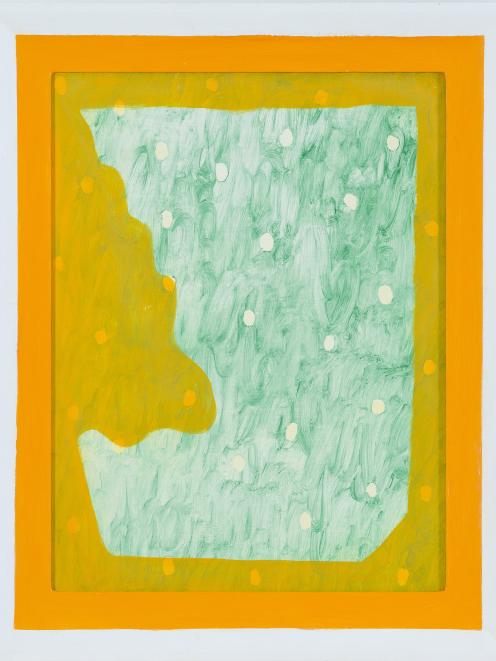

She likes to be up close to her work and be able to see everything at once.
Then she props the work - oil paint on gessoed aluminium board - up on a shelf at the end of her studio to look at it from a distance.
"Colour is important. I aim for some kind of punch from a distance.
"I would like them to have a physical presence which belies their size but to still maintain a kind of reticence. Sort of a loud silent presence."
While Leek (48) describes her work as using figurative motifs, she thinks of the paintings as "almost abstract".
"I like to revisit the same territory repeatedly and see how my attention to it changes things over time."
She is attracted to basic forms and methods.
"The paintings draw as much from school-room techniques as more sophisticated art histories. I try to turn the volume up on simple."
Her work for her latest exhibition at the Dunedin Public Art Gallery - "Early Telepaths" - is a continuation of what she has been doing for a long time.
"I'm still trying to make sense of my formalist art school foundation by way of interests in the amateur, the minor, the basic. You'll find my whole repertoire of motifs - grapes, leaves, trees, suns, curtains etc - reworked yet again.
"Some of the paintings were developed from a period when I was doing a lot of monoprint drawings, so there are aspects of those creeping into the way I've applied paint."

That resulted in an exhibition called "Ghost Painting", which was installed in the same gallery she is exhibiting in this time.
"It was based on a Bill Manhire poem about the painting in the collection of Toitu picturing early European settlers picnicking in Woodhaugh Gardens."
The DPAG also holds one of Leek's more quirky pieces - a large cardboard caravan.
During the late 1990s and early 2000s Leek made a few large cardboard sculptures but most were dismantled after the shows they were in.
"They were an extension of the kind of DIY aesthetic I was interested in at the time, using whatever cheap materials were to hand."
The caravan was made for a show in New Plymouth and it was destroyed just before she was asked to exhibit it in one of the Auckland Triennials, "Bright Paradise".
"It ended up in the Dunedin Public Art Gallery because they were the ones that said they would accept it as a donated artwork at short notice. I didn't want to destroy it and then have to remake it for a third time.
"For some reason, it holds a fascination for people. I'm always asked about it in interviews - perhaps because it's so different from what I usually do."
Another project which gained Leek attention was her participation in a Christchurch exhibition "Hangover".

They mentioned her to those organising the Hangover show - an exhibition of artists who "celebrated the low-brow" in their work.
"At the time I was painting confessional childhood narratives on stretched vinyl panels which drew on comics and zine culture."
It has been credited as raising her profile as an emerging artist.
"Yes, Hangover was an important show for me."
Intensity and focus had been part of her makeup since she was a "fifth former" (year 11) discovering painting was what she wanted to do as a career.
"I became quite serious about getting into art school."
She had a creative mother and grew up around artists and galleries, so the world was not unknown to her.
Her work is inspired by many things - music, pictures, writing, shapes, colours, walking down the street, boredom, anxiety.
"Really, inspiration is something that comes to you when you're least expecting it and a lot of the time that's just during the routine slog in the studio."
Much of her work in the studio is "sitting and looking, or thinking for a long time about simple decisions", she says.
"I consider myself very lucky to be able to do this as much as I do."
She chooses to work in a studio away from home.
"We don't really have the space at home and I think like any job it helps to get away from it sometimes and not have distractions when you are working."
She works better during the day as she is able to see colours better.
"I work in silence if I'm making decisions but have the radio or music on if I'm doing something which doesn't require thinking."
Over the years she has always had to have other jobs to support herself.
"Mostly, I've worked in bookshops and taught in art schools and done the occasional film job.
"Sometimes I do cleaning jobs because they fit well around an art practice and you don't have to think about them after you finish."
Leek, who was based in Auckland, came down to Dunedin with partner Nick Austin seven years ago when he received the Frances Hodgkins Fellowship.
"Initially, we only planned to be here for a year but we ended up staying.
"Once we were here, it was too hard to go back. We'd left our jobs to come down and Auckland was already getting too expensive to live as artists."












